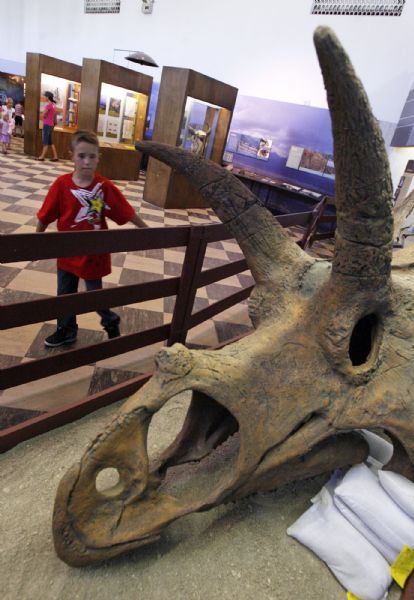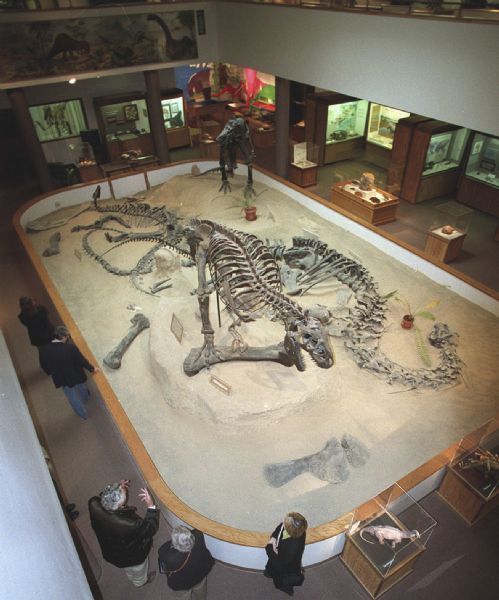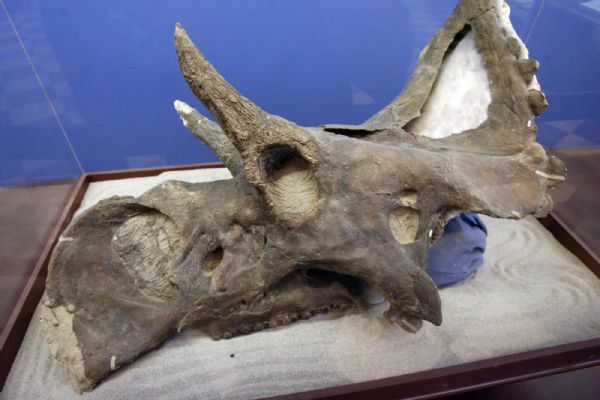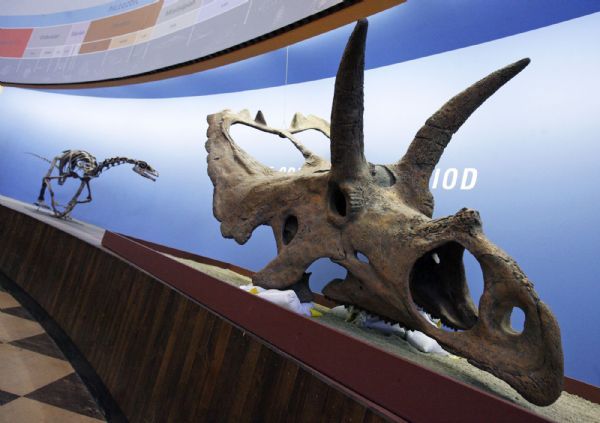This is an archived article that was published on sltrib.com in 2010, and information in the article may be outdated. It is provided only for personal research purposes and may not be reprinted.
Beneath Utahns' feet lies a treasure trove of bones, a paleontologist's dream.
More different types of dinosaurs have been found in Utah than in any other country in the world except China, said state paleontologist Jim Kirkland. And opportunities to see them -- above ground -- abound.
"We have the most continuous record of the history of dinosaurs of anywhere in the world," Kirkland said.
That's because mountains rose in and near Utah, shedding sediment that buried the dinosaur bones here at the beginning of the age of dinosaurs and toward the end. The whole region then rose in elevation, and rivers cutting through those mountains eroded the rocks enough for scientists to eventually find the buried bones, Kirkland said.
"It was basically fortuitous that we had mountains coming up on either side of our state," Kirkland said. "There are other places that have these rocks, but they're still buried, they weren't uplifted and eroded into like here."
The best thing about Utah's dinosaur history is that it's still being uncovered, according to Kirkland. "This is the golden age of Utah dinosaur discoveries right now," he said. The Tribune asked Kirkland to describe five of his favorite dinosaurs found in the state and where Utahns can see them today.
Utahraptor » This dinosaur, the biggest of all the raptors, lived about 125 million years ago
and was an aggressive, predatory animal. It was about as big as a polar bear and likely would have had remnants of feathers . This relatively big-brained dino also had huge claws on its feet, which it used to stab and disembowel its prey, said Kirkland, who led the team that found the animal in Utah near Arches National Park. He said the dino was a "very nasty, smart animal."
Where to look » College of Eastern Utah Prehistoric Museum, 155 E. Main St., Price
Info » $5 adults ($2 children; $15 family); hours 9-6 p.m. daily; 435-613-5060 or 800-817-9949, or visit www.ceu.edu/museum
And » Replica cast at Thanksgiving Point's Museum of Ancient Life, 3003 N. Thanksgiving Way, Lehi
Info » $10 adults ($8 children 3-12/seniors); hours 10 a.m.-8 p.m. Monday-Saturday; 801-768-2300 or 888-672-6040, or visit www.thanksgivingpoint.org
Gastonia » Gastonia also likely lived about 125 million years ago, but unlike Utahraptor, it was a plant eater.
Gastonia was
covered in bony plates and horns; even its eyelids were armored.
It had platelike spines sticking out sideways down its tail, which it likely swung at predators to defend itself. Kirkland also found this strange-looking animal with Utahraptor near Arches. "He's probably my all-time favorite," Kirkland said. "I just think he's an incredible, lovely, ugly dinosaur."
Where to look » College of Eastern Utah Prehistoric Museum, 155 E. Main St., Price
Info » $5 adults ($2 children; $15 family); hours 9-6 p.m. daily; 435-613-5060 or 800-817-9949, or www.ceu.edu/museum
And » Replica cast at Thanksgiving Point's Museum of Ancient Life, 3003 N. Thanksgiving Way, Lehi
Info » $10 adults ($8 children 3-12/seniors); hours 10 a.m.-8 p.m. Monday-Saturday; 801-768-2300 or 888-672-6040, or visit www.thanksgivingpoint.org
Eubrontes »
This name actually refers to large, three-toed tracks created by dinosaurs.
Kirkland said Utah probably has one of the largest concentrations of dinosaur track sites in the world. One of the best places to see them is the St. George Dinosaur Discovery Site, now a museum, located near the edge of prehistoric Lake Dixie about 200 million years ago, which
may have been as large as present-day Lake Michigan.
It's likely that the dinosaurs that created the tracks there were about 20 feet long and ate meat and fish, Kirkland said.
Where to look » Dinosaur Discovery Site at Johnson Farm, 2180 E. Riverside, St. George
Info » $6 adults, $3 children 4-11 (under four free); hours 10 a.m.-6 p.m. Monday-Saturday; 435-574-3466 or visit www.dinosite.org
Allosaurus » Utah's official state fossil was a large meat eater that lived about 150 to 145 million years ago. Allosaurus might have been as long as 35 feet and likely preyed on large, long-necked dinosaurs such as diplodocus, apatosaurus and camarusaurus. Allosaurus had a head full of sharp teeth, two distinctive horns near its eyes and three, clawed fingers at the end of each arm, which it likely used to grab things.
One of the best places to see these dinosaurs is at the Cleveland Lloyd Dinosaur Quarry, about 30 miles south of Price, where more than 50 of their skeletons have been excavated over the years.
Where to look » Cleveland Lloyd Dinosaur Quarry, located in the northern part of the San Rafael Swell, 32 miles south of Price
Directions » Take Hwy 10 south to the Cleveland/Elmo turnoff and follow the signs. The last 12 miles are on graded, unpaved road.
Info » $5 for adults, 16 and above; (children free); hours 10 a.m. to 5 p.m. daily, noon to 5 p.m. Sundays. Call 435-636-3600 for information, or visit www.blm.gov/ut/st/en/fo/price/recreation/quarry.html
Horned dinosaurs »
This isn't one dinosaur, but many different types of dinosaurs that, in some cases, are just now being uncovered and named in Utah. An example includes the diabloceratops, which was only officially named within this last year. Many of these dinosaurs lived 80 to 72 million years ago, and had horns they likely used to defend themselves and attract mates. Diabloceratops had more than 20 horns on its head, including two huge horns rising off a frill at the back of its head. Scientists are finding evidence of these types of dinosaurs in the Grand Staircase-Escalante National Monument.
Where to look » To see diabloceratops bones, visit the Utah Museum of Natural History, 1390 E. Presidents Circle, University of Utah campus, Salt Lake City
Info » $7 adults ($3.50 children 3-17; children under 3 free); hours 9:30 a.m.-5:30 p.m. daily, noon-5 p.m. Sundays. Call 801-581-6927 or visit http://umnh.utah.edu









